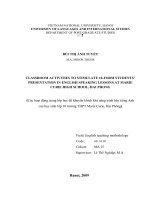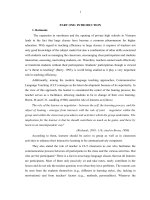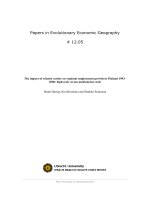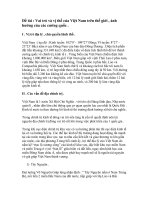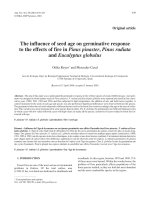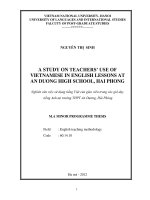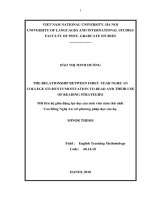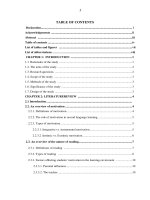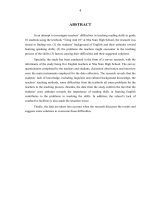The influence of reading topics on students’ motivation to read at Vinh Bao high school, Hai Phong = Ảnh hưởng của các chủ đề đọc tới động lực học kỹ năng đọc h
Bạn đang xem bản rút gọn của tài liệu. Xem và tải ngay bản đầy đủ của tài liệu tại đây (627.18 KB, 52 trang )
VIETNAM NATIONAL UNIVERSITY, HANOI
UNIVERSITY OF LANGUAGES AND INTERNATIONAL STUDIES
FACULITY OF POST- GRADUATE STUDIES
NGUYỄN THỊ THÚY MINH
THE INFLUENCE OF READING TOPICS
ON STUDENTS’ MOTIVATION TO READ AT VINH BAO
HIGH SCHOOL, HAI PHONG
Ảnh hưởng của các chủ đề đọc tới sự động lực học kỹ năng
đọc hiểu của học sinh trường THPT Vĩnh Bảo, Hải Phòng
M.A Minor Programme Thesis
Field: English Teaching Methodology
Code: 60.14.10
HANOI - 2012
VIETNAM NATIONAL UNIVERSITY, HANOI
UNIVERSITY OF LANGUAGES AND INTERNATIONAL STUDIES
FACULITY OF POST- GRADUATE STUDIES
NGUYỄN THỊ THÚY MINH
THE INFLUENCE OF READING TOPICS
ON STUDENTS’ MOTIVATION TO READ AT VINH BAO
HIGH SCHOOL, HAI PHONG
Ảnh hưởng của các chủ đề đọc tới đô
̣
ng lư
̣
c học kỹ năng
đọc hiểu của học sinh trường THPT Vĩnh Bảo, Hải Phòng
M.A Minor Programme Thesis
Field: English Teaching Methodology
Code: 60.14.10
Supervisor: Nguyễn Thị Mai Hữu, M.A
HANOI - 2012
iv
TABLE OF CONTENTS
DECLARATION…………………………………………………………….i
ACKNOWLEDGEMENT ii
ABSTRACT iii
TABLE OF CONTENTS ivii
LIST OF TABLES AND FIGURES vii
PART A: INTRODUCTION
1. Rationale for the study 1
2. Aims of the study 2
3. Research questions 2
4. Scope of the study 2
5. Significance of the study 2
6. Methods of the study 3
7. Design of the study 3
PART B: DEVELOPMENT 5
CHAPTER 1: LITERATURE REVIEW 5
1.1. Overview of motivation 5
1.1.1. Definitions of motivation 5
1.1.2. Types of motivation 5
1.1.2.1. Integrative vs. instrumental motivation 5
1.1.2.2. Intrinsic vs. extrinsic motivation 6
1.1.2.3. Global, situational and task motivation 7
1.1.2.4. Resultative motivation 7
1.1.3. Motivation in second language learning 7
1.2. Overview of reading 8
1.2.1. Definitions of reading 8
v
1.2.2. Types of reading 9
1.2.2.1 According to manners of reading 9
1.2.2.2 According to purposes of reading 11
1.2.3. Reading in foreign language learning 12
1.3. Motivation in learning reading 13
1.3.1. The importance of motivation in learning reading 13
1.3.2. Common factors affecting students’ motivation in learning
reading skill 14
1.3.2.1. The students 14
1.3.2.2. The teachers 15
1.3.2.3. The reading materials 15
CHAPTER 2: METHODOLOGY 17
2.1. Research methods 17
2.2. Research setting 17
2.2.1. The context of the study 17
2.2.2. Reading sections in TIENG ANH 10, 11 textbook 18
2.3. Participants of the study 19
2.4. Data collection instruments 19
2.4.1. Survey questionnaires for the teachers 19
2.4.2. Survey questionnaires for the students 20
2.4.3. Interview 20
2.5. Data collection procedures 21
2.6 Data analysis procedures 21
CHAPTER 3: DATA ANALYSIS AND FINDINGS 23
3.1. Students’ attitude towards reading skill 23
3.2. Types of students’ motivation in learning reading 24
vi
3.3. The students’ attitudes towards the current reading topics and their
preferences for reading topics ………………………………………………26
3.4. The influence of reading topics on students’ motivation to read 29
PART C: CONCLUSION…………………………………………………33
1. Conclusions……………………………………………………………….33
2. Implications……………………………………………………………….34
3. Limitations and suggestions for further studies………………………… 35
REFERENCES…………………………………………………………… 36
APPENDIXES……………………………………………………………… I
APPENDIX 1: SURVEY QUESTIONNAIRE FOR THE STUDENTS….I
APPENDIX 2: SURVEY QUESTIONNAIRE FOR THE TEACHERS V
APPENDIX 3: QUESTIONS FOR INTERVIEW …………………….VIII
vii
LIST OF TABLES AND FIGURES
I. LIST OF TABLES
Table 1: Students’ reasons for learning reading skill
Table 2: Students’ opinions on the current reading topics
Table 3: Students’ preferences for the current reading topics in English 10 textbook
Table 4: Students’ preferences for the current reading topics in English 11 textbook
II. LIST OF FIGURES
Figure 1: Student’s attitudes towards the importance of learning English reading
Figure 2: Students’ interest in learning reading skill
Figure 3: Students’ attitudes towards the role of reading topics to the
motivation for learning reading skill
Figure 4: Teacher’s attitudes towards the role of reading topics to motivate
their students in learning reading skill
1
PART A: INTRODUCTION
This part presents the rationale for choosing the topic, the aims of the
study, the research questions, the scope, the methods, the significance and the
design of the study in order to help readers have a general view on the
research.
1. Rationale for the study
Krashen & Terrel (1983:131) state that “Reading may contribute
significantly to competence in a second language. There is good reason, in
fact, to hypothesize that reading makes a contribution to overall competence,
to all four skills”. Reading is one of the major skills of learning a second or
foreign language and it has a prominent position in the design of a foreign
language teaching program. Reading skill helps the students to increase their
knowledge of English through exposure to language expressions, and
structures, and language contents as well. Therefore, teaching reading is
gaining more attention from both language teachers and language teaching
materials developers.
However, in Vietnam, many English learners complain that reading
always makes them feel bored and stressful. They seem to lack motivation to
read. In fact, motivation is an essential element in learning in general and in
learning reading in particular, but creating a motivated atmosphere for
students in a reading lesson is a challenging task.
For the above reasons, I would like to carry out “The influence of
reading topics on students’ motivation to read at Vinh Bao high school,
Hai Phong” to investigate the role of reading topics in learners’ motivation to
learn reading skill and to study their interests in reading topics. It is hoped
2
that the study will be helpful for English teachers in general and those at Vinh
Bao high school in particular to stimulate their students in a reading lesson.
2. Aims of the study
The study is aimed at:
- Identifying students’ motivation in learning reading skill at Vinh Bao high
school;
- Identifying students’ interests in the reading topics;
- Studying the influence of the reading topics on students’ motivation to learn
reading skill.
3. Research questions
The study was carried out in order to find out answers to the following
research questions:
1. What is students’ attitude towards learning reading skill?
2. What types of motivation do they have in learning reading?
3. How interesting do the students find the current reading topics?
4. What is the influence of the reading topics on students’ motivation to
read?
4. Scope of the study
With the limitation of the time, I will focus on the 11
th
- form students’
attitudes at Vinh Bao high school towards learning reading skill, the types of
motivation possessed by students, the students’ attitudes on current reading
topics and the influence of the reading topics on students’ motivation to learn
reading skill. Needless to say, it is necessary for the teachers to know what
their students like to read.
5. Significance of the study
The study highlights the influence of reading topics on the motivation
in learning reading skills.
3
The findings of the study are believed to be useful for English teachers
to be aware of the essential role of reading topics in the students’ motivation
to learn reading. Hopefully, it can help them to motivate students in learning
reading skills.
6. Methods of the study
The theoretical background of the study mainly is developed basing on
the references of and analysis on relevant theories about motivation and
reading. The study is carried out on the basis of survey questionnaires.
Firstly, for the theoretical basis, a lot of reference materials on
motivation and reading have been gathered, analyzed and synthesized
thoroughly with the clue consideration on the teachers’ and students’ teaching
and learning situations.
Secondly, interviews and questionnaires are carried out with teachers
and students of English to gather the most reliable data for the thesis.
7. Design of the study
The study is organized in three parts:
Part A: Introduction presents the rationale, the aims of the study, the
research questions, the scope of the study, the significance of the study, the
methods of the study and the design of the study.
Part B: Development consists of three chapters:
Chapter 1: Literature review provides theoretical background for the
study. Its focus is on introducing important relevant concepts, discussions of
issues and ideas on theories for motivation, nature of reading and motivation
in learning reading as well as factors affecting motivation in learning reading.
4
Chapter 2: Methodology presents the methods used in the study
including research methods, research setting , participants of the study, data
collection instruments, data collection and data analysis procedure.
Chapter 3: Data analysis and major findings shows the detailed results
together with a comprehensive analysis on the data collected from the survey
questionnaires and the interview.
Part C: Conclusion presents the conclusions, implications, limitations
and the suggestions for further study.
5
PART B: DEVELOPMENT
CHAPTER 1: LITERATURE REVIEW
In this chapter, the theoretical background for the study is provided.
The chapter focuses on three main features: overview of motivation, overview
of reading and motivation in reading skill.
1.1 Overview of motivation
1.1.1 Definitions of motivation
Many researchers have given definitions of motivation and most of
them agree that motivation is the force that makes one do something.
According to Kleinginna (1981:6), motivation is “a desire or want that
energizes and directs goal-oriented behavior”. Brown (2000:160) points out
that “motivation is some kinds of internal drove which pushes someone to do
things in order to achieve something”. Sharing the same point, Dornyei
(2001:7) suggests that “motivation explains why people decide to do
something, how hard they are going to pursue it and how long they are willing
to sustain the activities”
It is clear from the above definitions that different scholars approach
motivation definition differently. However, they all share the same point of
view that motivation combines external and internal influences.
1.1.2 Types of motivation
There have been many different distinctions between types of
motivation so far. They are integrative vs. instrumental motivation, intrinsic
vs. extrinsic motivation, global, situational and task motivation, and
resultative motivation.
1.1.2.1 Integrative vs. instrumental motivation
In 1972, Gardner and Lambert divided the motivation to learn a
language into two types: integrative motivation and instrumental motivation.
6
Integrative motivation stresses “a sincere and personal interest in the
people and culture represented by the other group”. Integrative motivation is
the desire to identify with and integrate into the target-language culture.
Instrumental motivation stresses “the practical value and advantages of
learning a new language”. Instrumental motivation is the wish to learn the
language for purposes of study or career promotion.
1.1.2.2 Intrinsic vs. extrinsic motivation
Moore, K.D., (1992) separates motivation into two main categories:
extrinsic motivation and intrinsic motivation.
Intrinsic motivation
Intrinsic motivation refers to “motivation to engage in an activity for its
own sake” (Wlodkowski - 1995). He means that activity itself is our benefit,
so we do not need any other kinds of rewards or punishments. According to
Moore (1992), “intrinsic motivation is what learners bring to learning
environment, that is, their internal attributes: attitudes, values, needs and
personality factors”.
Extrinsic motivation
Paul (2002) states that extrinsic motivation is “motivation to engage in
an activity as means to an end”. Moore (1992) gives easily understandable
definition that “extrinsic motivation originates outside the individual and is
concerned with external environments factors that help shape students’
behavior”.
It can be said that the main difference between intrinsic and extrinsic
motivation is the goals of the students. With intrinsic motivation, the students
study subject material for the sake of learning. These students find studying
enjoyable and learning new ideas as a reward itself. In contrast, with extrinsic
motivation, the students study for the sake of outside influences such as
7
getting teacher and peer praise, acquiring a good grade or some other type of
reinforcement that a teacher or peer might offer.
Intrinsic and extrinsic interact with each other and play an important
role in classroom motivation. Therefore, these two kinds of motivation seems
to be more useful for teachers.
1.1.2.3 Global, situational and task motivation
Brown (1990) identified three types of motivation:
Global motivation: the overall orientation of the learner towards the
learning of the foreign language.
Situational motivation: it has to do with the context learning (classroom,
total environment).
Task motivation: the way the learner approaches the specific task in
hand.
1.1.2.4 Resultative motivation
In some cases, motivation is the result of learning. Ellis (1997)
concluded that “the relationship between motivation and achievement is an
interactive one. A high level of motivation does stimulate learning, but
perceived success in achieving L2 goals can help to maintain existing
motivation and even create new types. Conversely, a vicious circle of low
motivation = low achievement = low motivation can develop”.
1.1.3 Motivation in second language learning
Motivation is one of the main determining factors in success in foreign
or second language learning. It is not only the cause of success but it can also
be the effect of success. Brown, H.D (1994) also affirmed that a learner will
be successful with proper motivation in learning. Rebeccal and Jill Sheorin
(1996:121) pointed out: “Motivation is important because it directly
influences how often students use second language learning strategies, how
8
much students interact with native speakers, how much input they receive in
the language being learned, how well they do on curriculum-related
achievement tests, how high their general proficiency level becomes, and how
long they preserve and maintain second language skills after language study is
over”.
Therefore, teachers should pay attention to developing both intrinsic
and extrinsic motivation for their students in learning.
1.2 Overview of reading
1.2.1 Definitions of reading
In the reading class, what the teacher understands about reading will
have a great influence on what he or she teaches in the classroom. Therefore,
for the teacher of reading, a careful look at definitions of reading is very
important.
However, defining reading is not easy although a lot of attempts have
been made to define it. Different people define the term reading in different
ways and each definition reflects a different viewpoint of reading. According
to Robinson and Good (1987: 9), “reading is best described as an
understanding between the author and the reader Reading is much more than
just pronouncing words correctly or simply knowing that the author intends; it
is the process whereby the printed page stimulates ideas, experiences and
responses that are unique to an individual. Reading can simply be thought of
as a personal encounter with the printed page. Basically, an important aspect
of reading is the process of constructing meaning from printed materials.”
Petty and Salzer (1989: 323) held a similar point of view, that is,
“reading involves the identification and recognition of printed or written
symbols which serve as stimulus for the recall of meanings built up through
past experience and further the construction of new meanings through the
9
reader's manipulation of relevant concepts already in his or her possession.
The resulting meanings are organized into thought processes according to the
purposes that are operating in the reader.”
Both of the above definitions indicate that reading is not only an
interaction between the reader and the author but also between the reader and
the text.
Although "no definition of reading can possibly include all viewpoints
and features" (Robinson and Good - 1987: 9), for the sake of teaching and
learning reading skills, the following definition should be emphasized:
“Reading means "reading and understanding". A foreign language learner
who says, "I can read the words but don't know what they mean" is not,
therefore, reading, in this sense. He or she is merely decoding - translating
written symbols into corresponding sounds.” (Ur - 1996: 138). This does not
mean that the reader needs to understand every word in a text but actively
work on the text and extract the required information efficiently.
1.2.2 Types of reading
Although there are different ways to classify reading, the most popular
one is to base on manners and purposes of reading (or reasons for reading).
1.2.2.1 According to manners of reading
Based on manners of reading, reading can be divided into reading aloud
and silent reading.
Reading aloud
According to Doff (1995: 67), “reading aloud involves looking at a text,
understanding it and also saying it”. What he meant is that when we read
aloud, our purpose is not just to understand a text but to convey the
information to someone else. In his opinion, “reading aloud can be useful at
10
the earliest stage of reading (recognizing letters and words); it can help
students to make the connection between sound and spelling”.
However, Doff (1995: 58) also pointed out that "for reading a text, it is
not a very useful technique" because it is not a natural activity – most people
do not read aloud in real life. In addition, when reading aloud, only one
student is active at a time while the others are either not listening at all or are
listening to a bad model. And students only pay attention to pronunciation,
not understanding the text. Besides, students usually read slowly because they
find it hard to read aloud in their own language, let alone in a foreign
language. Therefore, it takes up a lot of time in class.
Additionally, he wrote "if a teacher wants students to read aloud, it
should be the final activity at the end of a reading lesson". It can be suggested
that to make full use of this type of reading, a reading lesson must be carefully
prepared and carried out in various ways to motivate and encourage the
student to learn.
Silent reading
Different from reading aloud, silent reading is the normal and natural
activity that most students do in classroom as well as in real life. “Normally,
reading is a silent and individual activity since the writer's expectation was
that the text would be read, not heard” (Abbott and Wingard - 1985: 81).
Doff (1995: 67) added that “it involves looking at sentences and
understanding the message they convey, in other words, "making sense" of a
written text.” This means that when we read, we do not merely sit as "passive
receivers" of the text but we, based on our own knowledge of the world and
of the language, extract the required information and relate it with real life. In
addition, in silent reading, the student can read at his own speed and can go
back and read whatever he wants to understand more.
11
1.2.2.2 According to purposes of reading
According to most methodologists, reading is categorized into four
types: skimming, scanning, extensive reading and intensive reading.
Skimming
Skimming can be defined as follows: “By skimming we mean
glancing rapidly through a text to determine its gist, for example in order to
decide whether a research paper is relevant to our own work , or in order to
keep ourselves superficially informed about matters that are not of great
importance to us” (Nuttall - 1989: 34). Or simply speaking, when skimming,
we go through the reading material quickly to get general sense or the gist of it
without being concerned with the details. Therefore, skimming should be
treated as a useful skill in teaching and learning reading and can be applied at
the first stage of a reading lesson with the aim that the student can have an
overview of what he is going to read.
Scanning
Scanning is also a necessary technique in reading efficiently.
Nuttall (1989: 34) stated that “by scanning we mean glancing rapidly
through a text either to search for a specific piece of information or to get
an initial impression of whether the text is suitable for a given purpose ”
Unlike skimming, scanning is a kind of reading carried out when we go through
the text very fast in order to find a particular item of information, then
concentrate on it. When scanning, we only try to find what we are looking for.
Therefore, this kind of reading can be very useful in reading selectively.
Extensive reading
Extensive reading is also called "reading for fluency". The student
reads long texts to have general understanding, to practice his fluency in
reading, or to relax. Therefore, this kind of reading is often carried out
12
individually outside classroom. In general, the student should be encouraged
to do extensive reading to improve his knowledge of the world as well as of
the target language or simply to foster fluency and pleasure.
Intensive reading
In contrast with extensive reading, intensive reading requires full
understanding of the text. Nuttall (1989: 23) wrote “intensive reading
involves approaching the text under the close guidance of the teacher , or
under the guidance of a task which forces the student to pay great attention to
the text. The aim of intensive reading is to arrive at a profound and detailed
understanding of the text: not only of what it means, but also of how the
meaning is produced. The "how" is as important as the "what", for the
intensive reading lesson is intended primarily to train students in reading
strategies.” Accordingly, intensive reading should be a basic activity in a
reading classroom.
In conclusion, the above kinds of reading are closely related. They can
be used either alternatively or in combination in reading one text. The teacher
of reading should vary reading strategies and make full use of each kind of
reading. Furthermore, to make the teaching and learning reading better, the
teacher should select activities suitable for promoting reading skill.
1.2.3 Reading in foreign language learning
In reality, the ability to read is very important to personal development,
academic studies, professional success, etc. Therefore, it is agreed that
1. Where there is little reading, there will be little language learning. It
will be true for a few years yet that the student who wants to learn
English will have to read himself into knowledge of it unless he can
move into an English environment. He must substitute imaginary for
actual experience;
13
2. Only by reading can the pupil acquire the speed and skills he will need for
practical purposes when he leaves school. In our literate society, it is hard
to imagine any skilled work that does not require the ability to read;
3. Further education depends on quantity and quality of reading. All the
important study skills require quick, efficient and imaginative reading;
and
4. General knowledge depends on reading. The "background" or cross -
culture problem can only is tackled by wide reading. The more the
student reads, the more background knowledge he acquires of other
ways of life, behavior and thought and the more books he finds he can
understand.
(Bright & McGregor - 1977: 52)
Thus, it can be said that reading is the core of the syllabus as it helps
students broaden their general knowledge as well as professional one,
improve other language skills and succeed in their future life. As a result, it is
the teacher of reading that helps and motivates students to learn to read so that
they can read to learn.
1.3 Motivation in learning reading
1.3.1 The importance of motivation in learning reading
It can be clearly seen that reading motivation plays a crucial role in
second language reading process. Most academic knowledge is gained
through reading so students must read often throughout their school years.
Reading motivation refers to the desire to read even when not required
to do so and involves seeking out opportunities to read for curiosity,
knowledge and involvement. Reading researchers recognized that in order to
create lifelong readers, endowing the learners with proficient reading skills is
not enough. They also need to have internalized motivation. Reader’s
14
motivation has been shown to relate to the quality of the outcome of reading.
Many studies have shown that bad readers lack motivation to read or to spend
time improving their ability to read. Therefore, “it is an important part of a
reading teacher’s job to motivate learners” (Girard, 1977:20).
1.3.2 Common factors affecting students’ motivation in learning reading
skill
1.3.2.1 The students
The most important factor affecting motivation in learning reading is
the students.
Students’ attitude toward reading has a great impact on reading
motivation. Aebersold and Field (1997:39) say that: “The more interested
people are, the more they will preserve in reading”. If students show no
interest in the text, it means that they do not want to read then the reading
activity will become a pressure to them and even the reading process may not
happen at all. In reality, most of what we read such as books, magazines,
advertisements, etc is what we really want to read. So it can be concluded that
the degree of interest has its influence on reading motivation.
Besides, the students’ background knowledge also dominates their
motivation to read. Without background knowledge, the students would meet
a lot of difficulties in comprehending the text and even the language
comprehension could not take place at all. Consequently, the students would
lose their interest in reading and never read any more.
Moreover, the students’ success is a strong factor influencing their
motivation in learning reading. As human being, we generally like what we
do well, and therefore we are more likely to do it again and put in more effort.
If students put in more effort, they will get better results and so this sustains
their motivation.
15
1.3.2.2 The teachers
The other important factor is the teachers. Ericksen (1978: 3) wrote that
“Effective learning in the classroom depend on the teacher’s ability…to
maintain the interest that brought students to the course in the first place.”
The teachers should employ suitable techniques or methods of teaching
to help the students to develop their competence as readers during the reading
lessons. The teachers can help the students to get involved in dealing with the
reading texts. A good and suitable method of teaching can help the students
find more easily to understand the reading texts therefore they become more
motivated to read. Moreover, the teachers’ activities and tasks are the key
component to the students’ motivation in learning reading skill.
In addition, the teacher’s personality and attitude towards the students
play a prime role in affecting both student motivation and progress. Many
educational researchers admit that the teacher with warm, sensitive,
enthusiastic and humorous characteristics would be more likely successful in
teaching than the ones without those characteristics. Those teachers, who are
enthusiastic in teaching have a positive attitude to the subject and the students,
would be capable of keeping students interested in reading.
Finally, the way the teacher assesses and evaluates the students’
progress also influences their motivation in learning the subject. The teacher
should not compare the performance of a student to that of the others but
encourage and create a supportive environment for them to put more effort. It
is important to evaluate their progress with themselves in order to make them
more self – confident and motivated.
1.3.2.3 The reading materials
The reading materials play an important role to students’ motivation in
reading in terms of its level of challenge, its topic and content. Reading
16
materials that are interesting and relevant to the students will motivate them to
read more.
Firstly, reading materials should have suitable topics and contents, this
means, the texts should interest the students. Nuttal (1982:70) points out that
“the texts that are considered suitable will tell the students things they do not
know and introduce them to new and relevant ideas”. In the case the topic of
the text is not interesting and irrelevant to their experience and knowledge
they may stop reading because they cannot understand the meaning of the text
enough to satisfy their expectations, need or interests. In general, if students
enjoy what they read, the reading comprehension is the best achieved.
Secondly, reading materials’ vocabulary and grammatical structures
also have an impact on the students’ motivation. The students would also be
tired when encountering with a great deal of new words, complex sentence
structures and so on. In terms of linguistic items, the vocabulary in the
reading text must be of appropriate level. The complexity of grammar must
not be too great. Besides, the background of the text must be within the
students’ imaginative grasp.
Therefore, it is a challenge for the teacher to select or exploit the texts
in the ways that improves students’ interests and motivation in reading.
In summary, some theoretical background knowledge related to
motivation and reading skills has been presented in this chapter. The chapter
has discussed some concepts and ideas concerning motivation, types of
motivation and its role on second language learning. In addition, definitions,
types and roles of reading skill have been presented. Especially, the chapter
has mentioned some aspects related to factors affecting students’ motivation
in learning reading comprehension skill. The following chapter will display
the detailed description of the methodology.
17
CHAPTER 2: METHODOLOGY
This chapter presents the methods used in the study including research
methods, research setting, participants of the study, data collection
instruments, data collection and data analysis procedure.
2.1 Research methods
In this study, the researcher applied questionnaires as a main means of
data collection because of some advantages. Firstly, this method can give the
researcher the needed data in quantitative form. Secondly, all informants have
the chance of expressing their attitudes. However, the using of questionnaires
also has some limitations: the answers may be simple and superficial, the
respondents are unreliable and motivated. Therefore, interviews were carried
out. As a result, the researcher can have more uniform and accurate data.
2.2 Research setting
2.2.1 The setting of the study
The study was conducted at Vinh Bao high school, Hai Phong. For
about 20 recent years, English has been a compulsory subject and also the
only foreign language at the school. All of the students of Vinh Bao high
school have at least four years learning English at secondary schools. They
have to learn English for three years at high school before taking part in the
general education exam at the end of grade 12. Although the school is located
at Vinh Bao district, Hai Phong, the students have not many chances to
approach English language except reading their textbooks and studying at
schools.
The teaching and learning English at Vinh Bao high school follows the
new curriculum (since 2006) of The Ministry of Education and Training. All
18
the students learn the set of basic program textbooks Tieng Anh 10, Tieng
Anh 11, Tieng Anh 12 which includes 315 periods of 45 minutes in the class.
It means that students have 3 classes of English per week, equivalents with
105 classes per school year.
Reading skill is taught in 16 periods per school year, in which students
read 16 different texts of the six themes: You and me, Education, Community,
Nature and environment, Recreation, People and places. Students are trained
to improve such reading strategies as: skimming for gist, scanning for specific
information, drawing conclusion, making inferences and restatements, writing
summaries.
In Vinh Bao high school, the English group has 11 teachers. The oldest
teachers have more than 25 years of teaching experience and the youngest
ones have more than three years of experience. All of them are very
enthusiastic and willing to apply better methods to upgrade their teaching
quality.
2.2.2 Reading section in TIENG ANH 10, 11 textbooks
Every unit in TIENG ANH 10, 11, textbook begins with a reading
section, which is aimed at developing students’ reading skills, getting them
accustomed to the topic and providing language input so that they can speak,
listen and write better in the following lessons. The length of each reading
passage is 240 – 270 words. The reading parts are presented with various
colored pictures to raise students’ interests in the reading topic. A reading
lesson is taught in three stages: before you read, while you read and after you
read. “Before you read” helps students get involved in the topic and content of
the reading passage, presents some new vocabulary required for their
comprehension. “While you read” consists of two or three tasks that ask
19
students to read for main ideas or details, finally grasp the content of the text.
“After you read” focuses on consolidating students’ comprehension by such
activities as summarizing, retelling the reading passage.
2.3 Participants of the study
The study was carried out with the participation of 82 students of grade
11 at Vinh Bao high school. They are at the age of 17-18 and have learnt
English for (at least) 4 years at secondary school and two years at Vinh Bao
high school. Of the 82 participants, 56 students (68.3%) are female and 26
students (31.7%) are male. All of them are living in the countryside and have
not many chances to approach English language except reading their
textbooks.
Besides, ten teachers of English at Vinh Bao high school were also
invited to take part in this study by answering the survey questionnaires and
the interview. Among them, two teachers are male and the others are female.
All of them have been teaching English at the school for years.
2.4 Data collection instruments
To obtain the information for the study, the researcher used two
instruments: questionnaires for the teachers and questionnaires for the
students.
2.4.1 Instrument one: Questionnaire for the teachers
The survey questionnaire for the teachers included three parts:
The first part was designed to gather personal information about the
teachers (their gender, age, teaching experience)
The second part consisted of six questions. It was designed to get the
teachers’ opinions about the importance of reading to their students, teachers’
